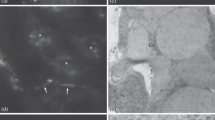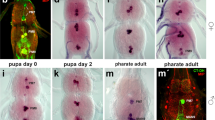Summary
-
1.
The release of octopamine by the central nervous system of the leechMacrobdella decora was examined. Isolated ganglia or chains of ganglia were incubated in salines of varying composition, and the release of octopamine into the perfusate was measured using a radioenzymatic method. In some experiments this release was correlated with the electrical activity of the octopamine-containing Leydig cells, as measured via a microelectrode in the cell body.
-
2.
Chains of ganglia incubated in normal saline released 0.04 pmol octopamine/ganglion/3 min incubation period. This amount was not significantly increased by either the monoamine oxidase inhibitor iproniazid phosphate (0.1 mM) or the uptake inhibitor desipramine (10 μM) alone, but was by both together. Nominally calcium-free saline containing 20 mM Mg++ significantly decreased octopamine release.
-
3.
High K+ saline increased octopamine release significantly in both standard saline and one containing the blocking agents. This increase was sevenfold in saline containing iproniazid phosphate and desipramine, and was significantly greater than that obtained in saline without the blockers. This provides further evidence for the role of octopamine as a neuroactive substance in the leech by indicating the existence of possible mechanisms for its uptake and/or inactivation.
-
4.
Octopamine release was positively correlated with the firing frequency of Leydig cells. No release was detectable when the cells were prevented from firing by the injection of hyperpolarizing current. Release was frequency-dependent when the cells fired at frequencies of 0.1–1.0 spikes/s. Elevating the external calcium concentration from 1.8 to 5.4 mM significantly increased octopamine release at all frequencies tested, except for 0 spikes/s, at which release remained below detectability.
-
5.
Bathing intact animals in 10−4 M octopamine significantly elevated their activity levels above those of controls. This increase was blocked by phentolamine.
-
6.
These data, together with the previous demonstrations that Leydig cells contain octopamine and that octopamine is present in leech blood, provide conclusive evidence that Leydig cells are octopaminergic, and suggest that octopamine has a neurohormonal role in the leech.
Similar content being viewed by others
References
Arbas EA, Calabrese RL (1983) Leydig cell activity modulates heartbeat pattern generator cycling in the leech. Soc Neurosci Abstr 9:755
Belanger JH, Orchard I (1986a) Leydig cells: octopaminergic neurons in the leech. Brain Res 382:387–391
Belanger JH, Orchard I (1986b) Studies on the release of octopamine from the central nervous system of the leechMacrobdella decora. Soc Neurosci Abstr 12:246
Carlson AD, Jalenak M (1986) Release of octopamine from the photomotor neurones of the larval firefly lanterns. J Exp Biol 122:453–457
Corte LD, Nistri A (1974) Amine oxidase activity in tissues of the leech (Hirudo medicinalis). Br J Pharmacol 52:129 P
Davenport AP, Evans PD (1984) Stress-induced changes in the octopamine levels of insect haemolymph. Insect Biochem 14:135–143
Evans PD (1978) Octopamine: A high-affinity uptake mechanism in the nervous system of the cockroach. J Neurochem 30:1015–1022
Evans PD (1981) Multiple receptor types for octopamine in the locust. J Physiol 318:99–122
Gerschenfeld HM, Hamon M, Paupardin-Tritsch D (1978) Release of endogenous serotonin from two identified serotonin-containing neurones and the physiological role of serotonin re-uptake. J Physiol 274:265–278
Harris-Warrick RM, Kravitz EA (1984) Cellular mechanisms for modulation of posture by octopamine and serotonin in the lobster. J Neurosci 4:1976–1993
Hoyle G (1985) Neurotransmitters, neuromodulators, and neurohormones. In: Gilles R, Balthazart J (eds) Neurobiology, Springer, Berlin Heidelberg New York, pp 264–279
Keyser KT, Frazer BM, Lent CM (1982) Physiological and anatomical properties of Leydig cells in the segmental nervous system of the leech. J Comp Physiol 146:379–392
Konishi S, Kravitz EA (1978) The physiological properties of amine-containing neurones in the lobster nervous system. J Physiol 279:215–229
Leake LD, Walker RJ (1980) Invertebrate neuropharmacology. Blackie and Son, Glasgow
Lent CM, Dickinson MH (1984) Serotonin integrates the feeding behaviour of the medicinal leech. J Comp Physiol A 154:457–471
Morton DB, Evans PD (1984) Octopamine release from an identified neurone in the locust. J Exp Biol 113:269–287
Nicholls JG, Purves D (1970) Monosynaptic chemical and electrical connexions between sensory and motor cells in the central nervous system of the leech. J Physiol 209:647–667
Nicholls J, Wallace BG (1978) Quantal analysis of transmitter release at an inhibitory synapse in the central nervous system of the leech. J Physiol 281:171–185
Orchard I (1982) Octopamine in insects: neurotransmitter, neurohormone, and neuromodulator. Can J Zool 60:659–669
Orchard I, Lange AB (1985) Evidence for octopaminergic modulation of an insect muscle. J Neurobiol 16:171–181
Orchard I, Lange AB (1987a) The release of octopamine and proctolin from an insect visceral muscle: Effects of high potassium saline and neural stimulation. Brain Res 413:251–258
Orchard I, Lange AB (1987b) Octopamine in insects, with special reference to the control of hemolymph lipid and control of the visceral muscles in locusts. Am Chem Soc Symp Series (in press)
Orchard I, Loughton BG, Webb RA (1981) Octopamine and short-term hyperlipaemia in the locust. Gen Comp Endocrinol 45:175–180
O'Shea M, Evans PD (1979) Potentiation of neuromuscular transmission by an octopaminergic neurone in the locust. J Exp Biol 79:169–190
Sokal RR, Rohlf FJ (1973) Introduction to biostatistics. Freeman, San Francisco
Sombati S, Hoyle G (1984) Generation of specific behaviours in a locust by local release in neuropil of the natural neuromodulator octopamine. J Neurobiol 15:481–506
Sunderland AJ, Leake LD, Walker RJ (1982) Structure-activity studies of the amine receptor on the Retzius cells of the leechesHirudo medicinalis andHaemopis sanguisuga. Comp Biochem Physiol 73C:347–352
Wallace BG (1981) Neurotransmitter chemistry. In: Muller KJ, Nicholls JG, Stent GS (eds) Neurobiology of the leech. Cold Spring Harbor Laboratory, Cold Spring Harbor, pp 147–172
Webb RA, Orchard I (1979) The distribution of putative neurosecretory cells in the central nervous system of the North American medicinal leechMacrobdella decora. Can J Zool 57:1905–1914
Webb RA, Orchard I (1980) Octopamine in leeches I. Distribution of octopamine inMacrobdella decora andErpobdella octoculata. Comp Biochem Physiol 67C: 135–140
Webb RA, Orchard I (1981) Octopamine in leeches. II. Synthesis, release and reuptake of octopamine by the ventral nerve cord ofErpobdella octoculata. Comp Biochem Physiol 70C: 201–207
Willard AL (1981) Effects of serotonin on the generation of the motor program for swimming by the medicinal leech. J Neurosci 1:936–944
Author information
Authors and Affiliations
Rights and permissions
About this article
Cite this article
Belanger, J.H., Orchard, I. Release of octopamine by Leydig cells in the central nervous system of the leechMacrobdella decora, and its possible neurohormonal role. J. Comp. Physiol. 162, 405–412 (1988). https://doi.org/10.1007/BF00606127
Accepted:
Issue Date:
DOI: https://doi.org/10.1007/BF00606127




